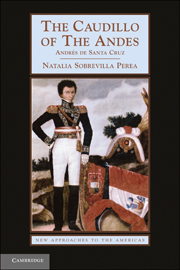Book contents
- Frontmatter
- Contents
- List of Maps and Illustrations
- Timeline for Santa Cruz
- Acknowledgments
- Introduction
- 1 Early Years at the Twilight of the Colonial Period
- 2 Great Marshall of Zepita
- 3 The Creation of Bolivia
- 4 The Genesis of the Peru-Bolivia Confederation
- 5 The Rise and Fall of the Peru-Bolivia Confederation
- 6 Defeat and Exile
- Epilogue: The Long-Term Consequences of the Fall of the Confederation
- Bibliography
- Index
4 - The Genesis of the Peru-Bolivia Confederation
Published online by Cambridge University Press: 05 June 2012
- Frontmatter
- Contents
- List of Maps and Illustrations
- Timeline for Santa Cruz
- Acknowledgments
- Introduction
- 1 Early Years at the Twilight of the Colonial Period
- 2 Great Marshall of Zepita
- 3 The Creation of Bolivia
- 4 The Genesis of the Peru-Bolivia Confederation
- 5 The Rise and Fall of the Peru-Bolivia Confederation
- 6 Defeat and Exile
- Epilogue: The Long-Term Consequences of the Fall of the Confederation
- Bibliography
- Index
Summary
One of the most difficult issues to resolve after independence was that of identity. The problem was particularly acute in border areas, and individuals who felt ties to more than one new republic found it most challenging. This was the case for Santa Cruz. He had tried to remain linked to Peruvian politics, but eventually had to come to terms with being limited in what he could do politically in Peru, because his enemies had successfully portrayed him as a foreigner. Although he accepted the presidency of Bolivia and took to it with all his energy and determination, he was still convinced that it was possible and advantageous to unite Peru and Bolivia in a federation. Santa Cruz was not alone, and indeed there were many important links between these territories that made a union possible to imagine. Many people in southern Peru and northern Bolivia were convinced that they belonged together. Santa Cruz was persuaded that the union would become a reality only if Bolivia became strong. So he dedicated all his energy to consolidating his country and to strengthening the economy and the army. He believed that if he was able to end political wrangling and have the backing of an organized military, he would be able to convince Peruvians to join a mutually beneficial federation. Peru, on the other hand, was marred by instability, because Santa Cruz's ability as an administrator was matched by Gamarra's inability to maintain control in Peru.
- Type
- Chapter
- Information
- The Caudillo of the AndesAndrés de Santa Cruz, pp. 114 - 146Publisher: Cambridge University PressPrint publication year: 2011



